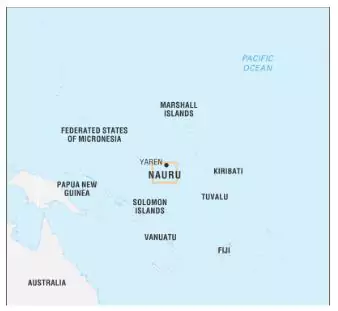Nauru, a small Pacific microstate, has introduced a unique “climate resilience citizenship” programme, selling passports at US$105,000 each.
The funds are aimed at combating climate change.
- The “climate resilience citizenship” scheme could be linked to broader discussions on financing climate action, the role of global cooperation, and the effectiveness of non-traditional funding models.
About Nauru
- Location & Geography: Nauru is located in the Pacific Ocean and a microstate in Oceania, roughly 1,300 km north of Australia.
- The island is dominated by a central phosphate plateau which is surrounded by coral cliffs
- There are no rivers and lakes on the Island; only a landlocked, freshwater lake – Buada Lagoon is found
 It is the third smallest country by land area in the world, covering only 21 square kilometers.
It is the third smallest country by land area in the world, covering only 21 square kilometers.- It is geographically positioned to the south of the Equator and hence lies both in the Southern and Eastern hemispheres of the Earth
- Population: Nauru has a population of around 10,000 people (one of the least populous nations).
- Lowest Point: The lowest point is the South Pacific Ocean
- Economy & Resources: Historically, Nauru’s economy was heavily reliant on phosphate mining, though reserves have dwindled.
- The island has limited agricultural land and natural resources, making it highly vulnerable to the impacts of climate change.
- Strategic Location: Nauru’s location in the Pacific also places it at the center of regional and global maritime routes, giving it geopolitical significance in terms of international relations in the Pacific region.
- Climate Vulnerability: As a low-lying island, Nauru faces severe threats from rising sea levels, making climate change resilience a top priority for its government.
![]() 8 Aug 2025
8 Aug 2025

 It is the third smallest country by land area in the world, covering only 21 square kilometers.
It is the third smallest country by land area in the world, covering only 21 square kilometers.